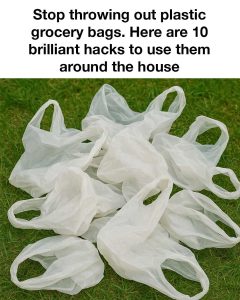In today’s world, where the consequences of plastic pollution are becoming harder to ignore, it’s essential to look for practical and creative ways to reduce our environmental footprint. Every year, millions of plastic grocery bags are discarded after just a few minutes of use, yet these same bags can take hundreds of years to decompose in landfills. While they offer convenience at checkout lines, their long-term environmental impact is staggering. Fortunately, with a little imagination, these bags can be reused in many different ways, transforming something often viewed as waste into a useful resource that helps protect our planet.

Plastic grocery bags are one of the most common forms of single-use plastic, and they contribute significantly to pollution on land and in our oceans. Because they are lightweight, they easily get carried by the wind and end up stuck in trees, littering streets, or floating in waterways. Their presence in the ocean is especially dangerous, as marine animals often mistake them for food. Ingesting plastic can lead to suffocation, starvation, or even death for sea turtles, fish, and birds. In addition, the production of plastic bags involves petroleum and natural gas, which adds to greenhouse gas emissions and accelerates climate change. The true cost of plastic bags is hidden behind their temporary convenience.
However, by reusing plastic grocery bags, we can lessen the burden on our environment. Instead of immediately throwing them away, giving them a second life serves two important purposes: it reduces the amount of waste sent to landfills and decreases the demand for new plastic products. It also inspires people to think more consciously about how they use and dispose of everyday items. Repurposing plastic bags isn’t just about saving money—it’s about developing sustainable habits that benefit our communities and the planet.
One of the most straightforward ways to reuse plastic grocery bags is by using them as liners for small trash cans. Whether it’s the bin in your bathroom, bedroom, or home office, these bags fit perfectly and make cleanup easy. You won’t need to purchase separate liners, which saves money while reducing waste. This everyday use is an example of how small actions can lead to meaningful environmental change.
Another clever idea is creating your own DIY plastic bag dispenser. Instead of stuffing bags into a drawer or cabinet where they quickly become messy and hard to manage, you can roll them into a compact tube and place them in an empty tissue box or a used wipes container. This keeps them organized and ready to grab when needed. Plus, it turns clutter into a neatly stored supply.
Plastic bags can also be used as waterproof shoe covers. On rainy days or muddy trails, simply slip a bag over each shoe and tie the handles around your ankles. This quick fix protects your shoes from the elements and can be especially helpful during outdoor events or unexpected downpours.
If you’re doing some painting around the house, plastic bags come in handy once again. When you need to take a break, wrap your paintbrush in a plastic bag and secure it with a rubber band. This prevents the bristles from drying out, saving you the hassle of cleaning and extending the life of your brush. It’s a smart way to avoid wasting both time and paint.
When it comes to packing fragile items, plastic bags can act as effective cushioning material. Crumple them up and place them around items like dishes, glassware, or electronics when moving or storing things. This method offers protection without having to buy bubble wrap or foam peanuts, and it gives plastic bags another chance to be useful.
In colder months, plastic bags can serve as plant protectors. Gardeners can place them over young or delicate plants during sudden frosts to help insulate them. Be sure to secure the bags with sticks or small weights so they don’t blow away in the wind. This simple technique can save plants from harsh weather, especially in early spring or late fall.
Plastic grocery bags also work well as reusable lunch sacks. They’re lightweight, easy to carry, and can be reused several times before needing replacement. Just make sure the bag is clean and doesn’t have any holes. It’s a great option for quick outings, school lunches, or casual work meals.
When you’re traveling, plastic bags can be used to keep dirty clothes separated from clean ones. Toss them into your suitcase to store worn items, and you’ll avoid mixing up laundry or spreading odors. This trick helps keep your luggage organized and your clothes fresher for longer.
For those who enjoy crafting, plastic bags can be turned into “plarn,” or plastic yarn. Cut the bags into strips, knot them together, and roll them into a ball. Plarn can be crocheted or knitted into durable items like tote bags, doormats, or storage baskets. This creative use not only recycles plastic but also provides a fun way to make handmade, sustainable products.
Lastly, keeping a plastic grocery bag in your car as a makeshift trash bag is a great way to maintain cleanliness on the go. Hang it from the headrest or keep it in the console so it’s always within reach. You can toss in receipts, snack wrappers, or other small bits of trash, making your drive more pleasant without needing a fancy car accessory.
In conclusion, giving plastic grocery bags a second life helps address one of the most pressing environmental challenges we face. Each of these small hacks offers a simple way to reduce waste and promote sustainable living. More importantly, they encourage a shift in mindset—from one of disposability to one of creativity and care. By rethinking how we use everyday items, we take an active role in protecting the environment and building a more responsible future. Let’s not underestimate the power of small actions. Together, these little steps can lead to lasting change—one plastic bag at a time.





